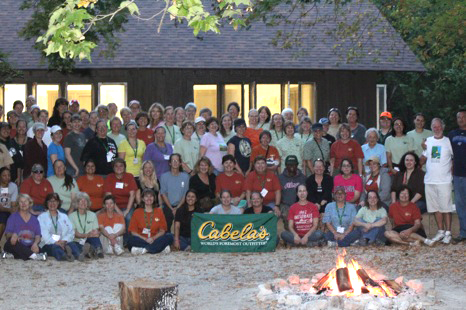Women Fastest Growing Outdoor Recreation Group
By Becky McKendry
Women are storming into the great outdoors faster than ever.
A recent survey by the U.S. Fish and Wildlife Service revealed that women are now the fastest growing outdoor recreation group. They now make up 27 percent of anglers.
The ongoing popularity of the international Becoming an Outdoors-Woman program, known as BOW, may be partly behind this trend.
Born in 1991, the program emerged as the brainchild of a conference held at the University of Wisconsin Stevens Point to identify barriers to the outdoors for women. The conference determined that limited access to outdoor education strongly hindered women from taking on activities like hunting or fishing, said BOW international director Peggy Farrell.

The 2013 BOW class held in Grafton, Illinois at Pere Marquette.
Photo: Illinois Department of Natural Resources.
This can affect the next generation of outdoor enthusiasts too, she said.
“There has been a lot of focus getting kids involved in the outdoors again,” Farrell said. “And moms are often the decision makers on money matters and leisure time, so if we don’t turn these women onto the outdoors, who is going to reinforce that lifestyle?”
Approaching its 23rd anniversary, BOW is present in 37 states and six Canadian provinces. Over the course of a weekend, it offers a variety of classes, from muzzle loading to learning how to use a map and compass. Fees vary from state to state and range from $150-$300 for a weekend.
The program is typically run through individual state agencies, such as the Department of Natural Resources or fish and game departments.
A program like BOW was desperately needed, said Farrell. And somewhere like the Great Lakes region, where seven out of eight Great Lakes states host a BOW program, is an especially important place to learn to love the outdoors.
“There is an abundance of natural resources in [the Great Lakes] region,” said Farrell. “Exposure to your ecosystem means you’re more likely to take care of it.”
In addition to fostering environmental stewardship, there appear to be economic bonuses as well.
“We’ve definitely heard some anecdotal evidence from local sporting goods stores that after a class, BOW participants will come in and buy equipment to carry on what they’ve learned,” said Nick Jamison, fish hatchery program administrator at the Ohio Department of Natural Resources.
Farrell says she has heard the same sentiment for years from individual coordinators across the nation.
“In 1995, we did some research with hard numbers that showed women would go out after their classes and purchase equipment, oftentimes the same brands they used at BOW,” she said.
The popularity of outdoor activities varies.
“Not too long ago, fly-fishing was so big we couldn’t fit all the people into classes,” Farrell said. “Now it’s archery, which some have speculated is because of the popularity of The Hunger Games series. But whatever it is, these interests stick with many of our participants.”
Although budget cuts have led to nine states losing the program since its beginning, Farrell said this doesn’t accurately reflect the success of the program.
“When state budgets are in trouble, even though it’s a very popular program, this tends to be one of the first things cut,” said Farrell. “But sometimes our classes are so popular we can’t accommodate all the participants.”
And it seems popular with women of all walks of life.
“In our program, we’ve had a lot of retired women, who tend to have more time on their hands,” Jamison said. “But really it’s open to almost anyone, as long as you’re over 18.”
And they mean almost anyone.
“In Wisconsin, our oldest participant was 93 years old,” said Farrell. “We try to reach out to all ages and socioeconomic statuses.”
To help this outreach, the BOW program offers scholarships to help low-income applicants pay program fees.
The goal is to not let money – or hesitancy – stand in the way between a woman and the great outdoors.
“Some women are tentative coming in because they’re out of their comfort zone,” said Farrell. “And by the time they’re done, they’re ready to go out, get their own gear and rock and roll.”
To find a BOW program in your state, click here for more information.
Credit © 2013, Great Lakes Echo, Michigan State University Knight Center for Environmental Journalism.
TOP
|